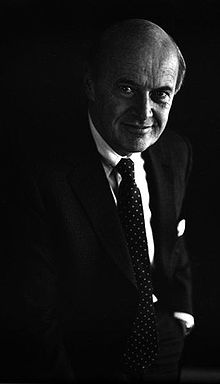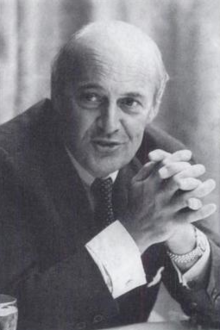- Charles Peter McColough
-
Charles Peter Philip Paul McColough (August 1, 1922 – December 13, 2006) was the joint creater, founder, and owner of the Xerox Corporation (along with Joseph C. Wilson), and was a former Chief Executive Officer and Chairman of the Board at Xerox. He retired in the late 1980s, after serving over 14 years as CEO. Aside from building Xerox to the corporate empire it is today, McColough was treasurer of the Democratic National Committee between 1974 and 1976, Chairman of United Way of America, and served on the Board of Trustees at Council on Foreign Relations, New York Stock Exchange, Bank of New York, Wachovia, Citibank, and Union Carbide Corporation. Included also in his work are the funding of the C. Peter McColough Roundtable Series on International Economics, part of the Council on Foreign Relations.
He resided with his wife Mary Virginia White McColough in Greenwich, Connecticut, and Palm Beach, Florida.
Contents
Family
C. Peter McColough was born on August 1, 1922, in Halifax, Nova Scotia, Canada, the firstborn child of the late Dr. and Mrs. Reginald Walker McColough. Dr. McColough was a Director of Public Works for the Parliament of Canada, and was responsible for the modernization and development of Cape Breton Island in northern Nova Scotia. His family descended from Godfrey McCulloch of Scotland and Sir Walter Scott. After attendance at Halifax private schools, McColough enrolled at Osgoode Law School in Toronto. He then attended Dalhousie University, where he received an honorary degree later in life. After Dalhousie, McColough studied at the Harvard Business School after briefly serving in the British Navy in World War II, and graduated in 1949. He became a US citizen in 1956.
While living and working in Philadelphia, Pennsylvania, McColough met and married socialite Mary Virginia White, daughter of James J. White, CEO of J.J. White and Company, one of the largest family-owned business in New England that is still in operation today. They had five children: Peter McColough (died 1987), Andrew McColough, twins Ian McColough and Virginia McColough Keeshan, and Robert McColough (died 1999).[1][2] The family lived in Rochester, New York until he moved the Xerox Headquarters to Stamford, Connecticut, and resided in the nearby suburb of Greenwich, Connecticut. McColough additionally had seven grandchildren: Alexander McColough, Charles McColough, Austin McColough, Peter McColough, Caroline Keeshan, Paul Keeshan, and Katherine McColough.
Career
McColough worked initially for Lehigh Navigation Coal Sales Company in the USA before making the switch in 1954 to Xerox, then a little known manufacturer of industrial photocopiers and still known as the Haloid Company. Five years after that career move, his new firm introduced its first office photocopier. As one of the first companies to step into the lucrative arena and potential growth market, Xerox's annual revenues soared from $40 million in 1960 to almost $3 billion in the early 1970s.
After taking over the presidency of the firm in 1966, McColough significantly changed and altered the direction and goals of Xerox Corporation. By 1979, McColough had built up Xerox revenues to $7 billion a year and its annual earnings to $563 million. The company's chief scientist told Forbes Magazine in 1980 that "in the late 1960s, Peter McColough redefined our company." From 1970 through to the mid-1980s he has held several directorships and in 1970, was honoured by his former alma mater, Dalhousie University, with an Honorary Doctorate.
Assessments
The consensus of various business and economic journalists is that McColough as CEO was a restless, energetic but amiable man who had little time for memos, letters and meetings that normally make up the routine of daily corporate life. McColough worked himself from an executive salesperson of Haloid to a multi-millionaire Chairman and CEO of Xerox.
McColough's philosophy was always one of strong leadership by example. He explained once to Business Week that "a company is made not only by the quality of its products and services, but also by its people, especially its top people," and in doing so revealed the key to his remarkable business career. On May 2, 1968, McColough and another Xerox executive sent out a memo announcing the company intended to start an affirmative action program, making Xerox one of the first companies to do so. McColough and Xerox have been both praised and criticized for it.
McColough started the PARC (Palo Alto Research Center), meant to operate something like AT&T's Bell Labs. PARC researchers developed pioneering commercial products in the field of personal computers—such as the Alto personal computer, GUI (graphical user interface), the WYSIWYG (What You See Is What You Get) editor, the first commercial mouse, Ethernet network architecture, OOP (object-oriented programming), PDL (Page Description Language), Internet protocols, and laser printing. But McColough and Xerox have been criticized for failing to take advantage of the opportunities PARC provided. "In spite of being a veritable cradle of innovation during the formative years of personal computing and the Internet, PARC rarely convinced Xerox to take its ideas from laboratory prototypes to commercially successful products," stated an article about PARC at the "Smart Computing in Plain English" Web site. "Many of the products were taken up successfully by other companies."
Death & Legacy
McColough died on December 13, 2006 after a long illness, according to his son Andrew McColough. His funeral took place in Greenwich, Connecticut, and was highly covered by international media outlets. Among those who gave eulogies were Vernon Jordan, a longtime friend and colleague, and David T. Kearns, another longtime friend who took over the reins at Xerox after McColough retired. He was survived by his wife, three children, seven grandchildren, and a sister, Patricia McColough Wallace of Halifax, Nova Scotia.
References
- ^ The International Who's Who, 1984–85 (48th ed.). Europa Publications. 1984. pp. 879. ISBN 0905118979.
- ^ Who's who in Finance and Industry: 1972–1973 (17th ed.). Marquis Who's Who. 1973. pp. 819.
Further reading
- Smith, Douglas K.; Alexander, Robert C. (1988). Fumbling the Future: How Xerox Invented, Then Ignored, the First Personal Computer. William Morrow & Co. ISBN 0688069592.
- Louis, Arthur M. (1981). The Tycoons. Simon & Schuster. ISBN 0671249746.
External links
Business positions Preceded by
Joseph C. WilsonPresident of Xerox Corporation
1966–1971Succeeded by
Archie R. McCardellPreceded by
Joseph C. WilsonCEO of Xerox Corporation
1968–1982Succeeded by
David T. KearnsPreceded by
Joseph C. WilsonChairman of Xerox Corporation
December 13, 1971–1985Succeeded by
David T. KearnsCategories:- 1922 births
- 2006 deaths
- People from Halifax, Nova Scotia
- Canadian people of British Isles descent
- Canadian emigrants to the United States
- American manufacturing businesspeople
- American chief executives
- Dalhousie University alumni
- Deaths from myocardial infarction
- Harvard Business School alumni
- Naturalized citizens of the United States
- People from Greenwich, Connecticut
- People from Palm Beach, Florida
- Xerox people
- Directors of Xerox
Wikimedia Foundation. 2010.


